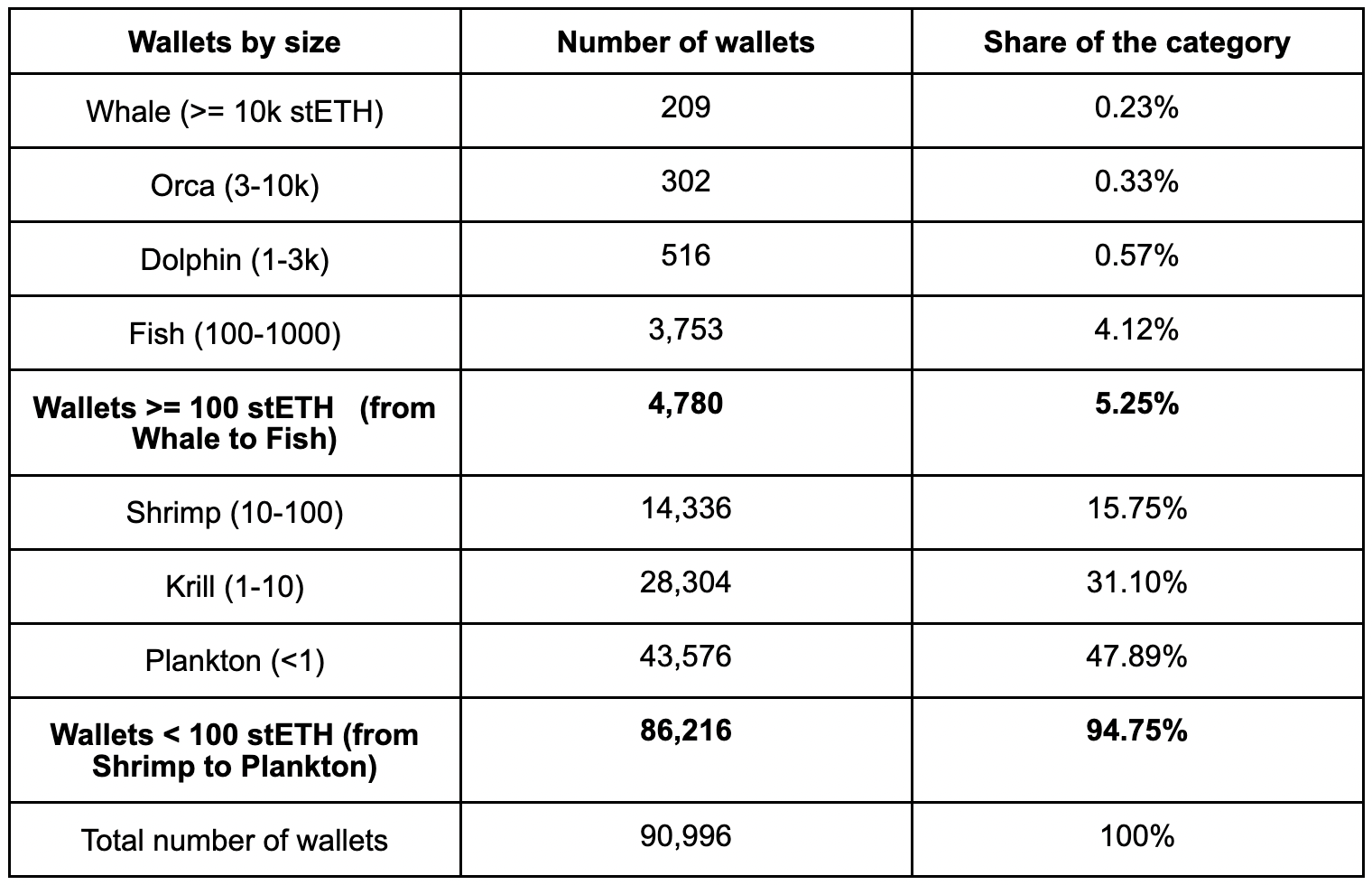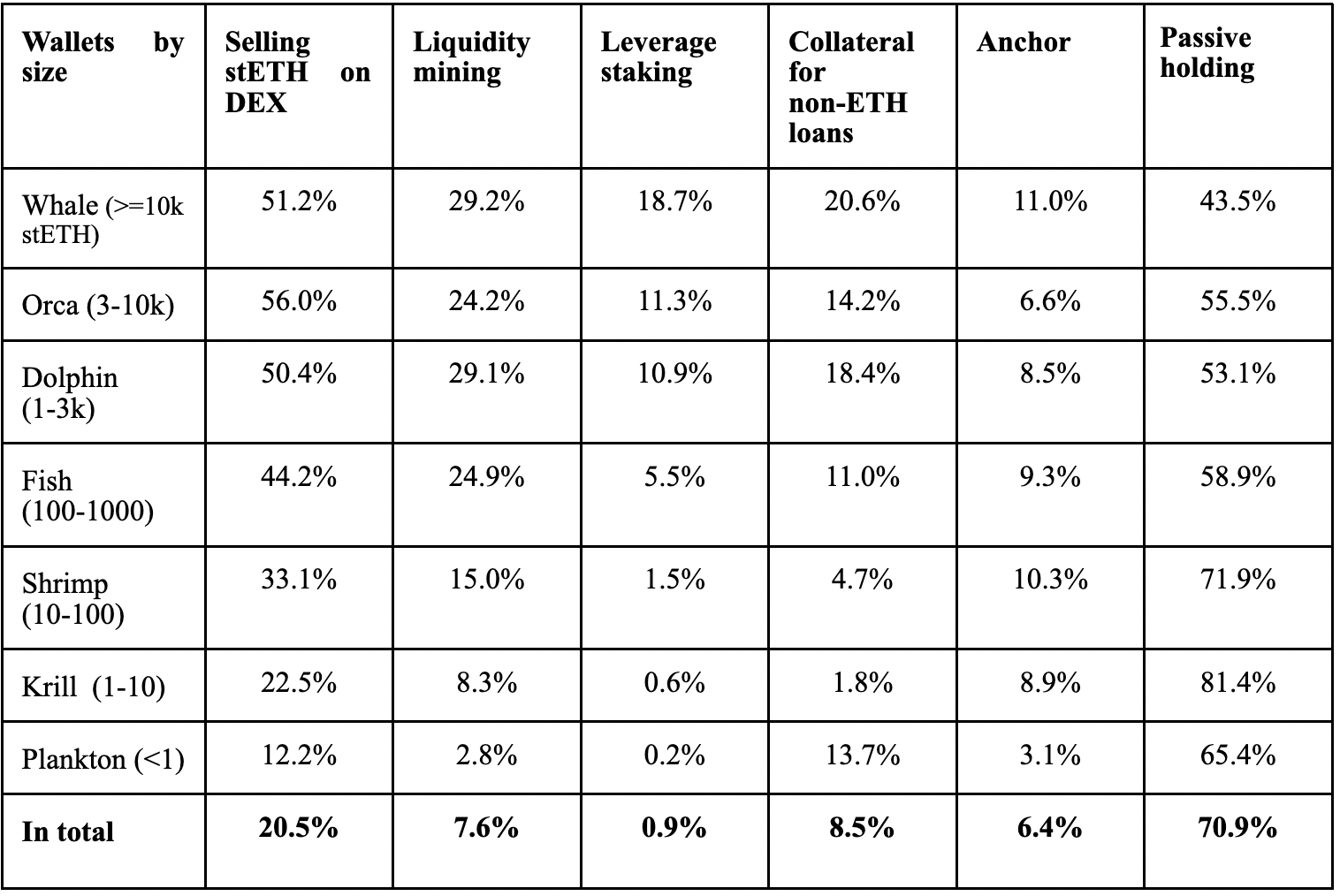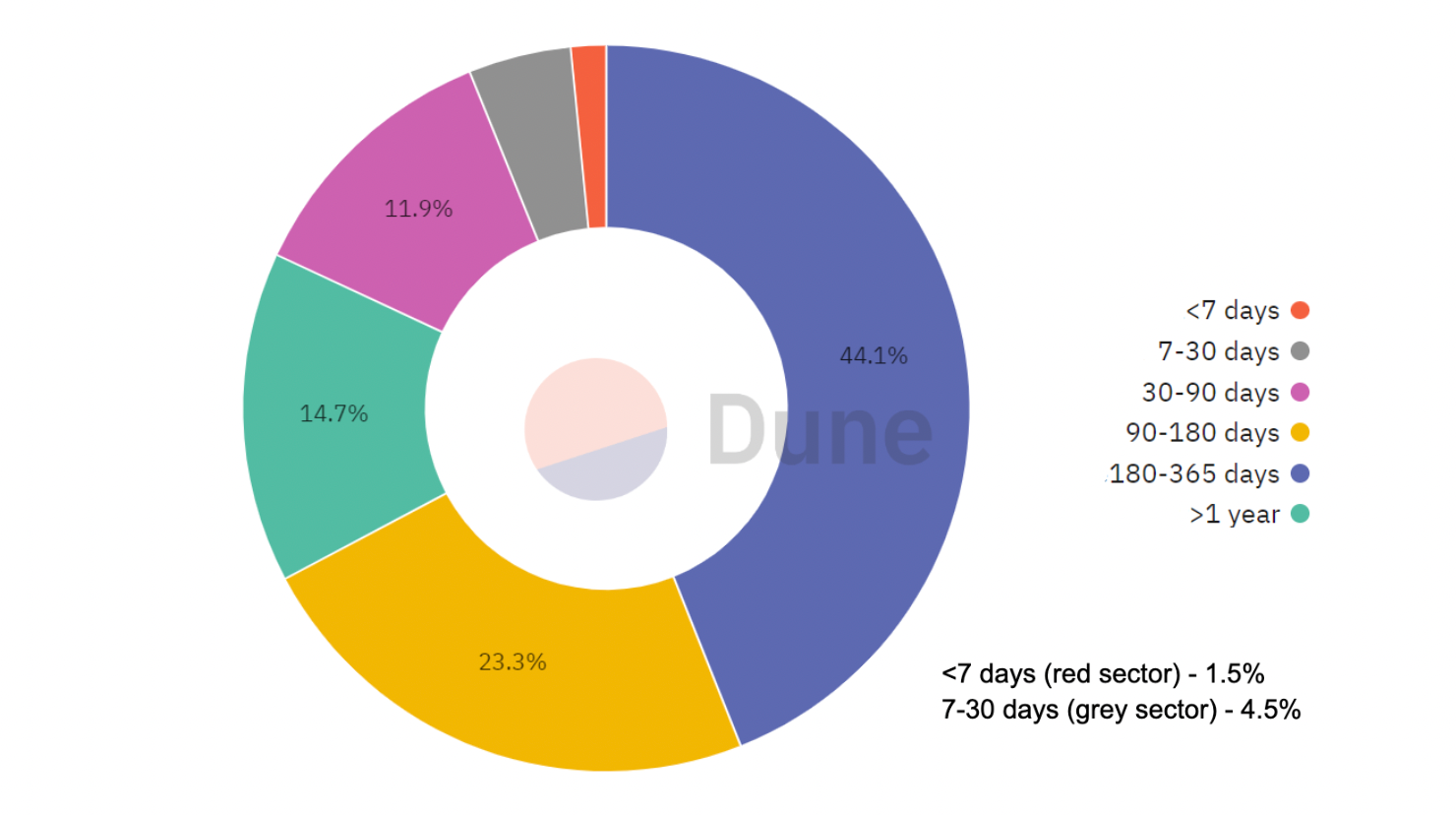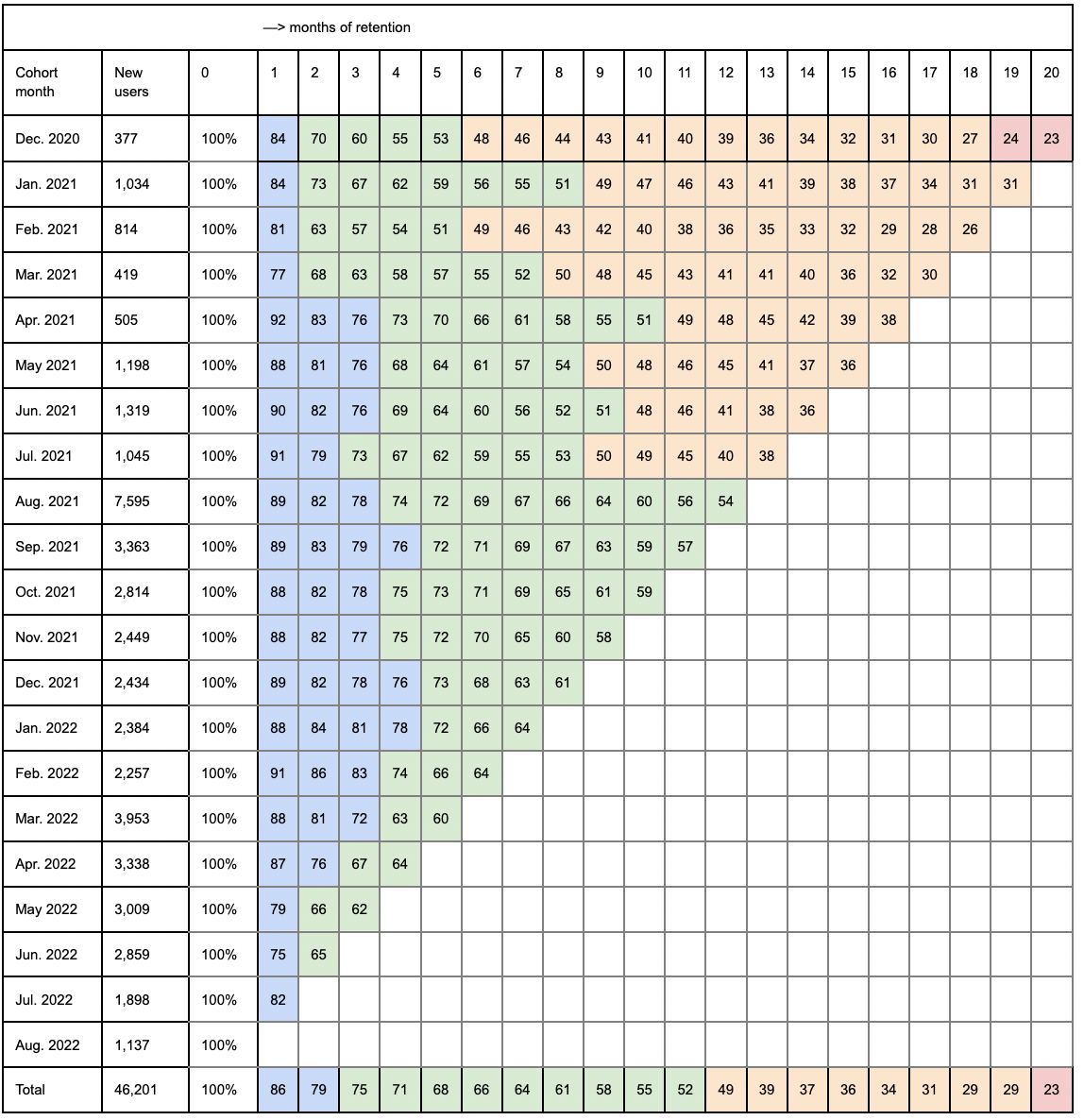Analysis of stETH User Behaviour Patterns

00 TL;DR
In an effort to better understand Lido users’ behaviour, below is a cohort analysis of various wallet sizes. We have come up with a classification system for wallets of different sizes, from Whales (>=10k stETH) all the way down to Plankton (<1 stETH).
The Lido ecosystem is diverse: a little more than 5% of all stETH addresses belong to the big wallets (so called Whales, Orcas, Dolphins, Fish, with more than 100 stETH). The rest of the addresses (95%) belong to the wallets with less than 100 stETH, known as Shrimp, Krill and Plankton.
In short, the major behaviour patterns of Lido users can be described as direct staking and passive holding, but if we dive deeper it’s not so simple.
For many small wallets direct staking is the only source they choose (83% of them are direct stakers). At the same time big wallets tend to diversify stETH sources: 54% of big wallets use direct staking, but they are also buying on DEX (49%) and receiving stETH from EOA and CEX (38%).
Passive holding is the most popular strategy among stETH users, aside from Whales. On average it was chosen by about 71% of Lido users, but by only 43% of Whales. Big wallets are more active on the secondary market than the small ones e.g., more than 25% of big wallets use liquidity mining, more than 16% use stETH as collateral, including leverage staking.
As for Lido users' loyalty (talking about wallets with >=1 stETH on the balance), an average period of stETH holding is about 225 days for now. Currently more than 82% of wallets have been with stETH on balance for more than 3 months, and more than 58% - for more than half a year.
Retention analysis reveals that 23% wallets that joined in December 2020 have been staying with Lido from the very beginning until now.
Current retention rate of 55% shows that over a half of the wallets that have ever interacted with stETH are still holding stETH/ its derivatives on their balance. We intend to track these retention and loyalty metrics over time.
01 Introduction
Do you know that Lido is a leading liquid staking protocol on Ethereum? Sure, you do. But who are the folks that stake with Lido? What strategies do they use? And how loyal are they to Lido? If you want to know, listen to our story.
To understand better our stETH users we split them into several categories (from Whales to Plankton) and then started to explore their behaviour and answer the questions:
- How do they get and use stETH?
- How long do they stay with Lido keeping stETH on their balance?
You may ask - Why do we yearn to answer these questions? - and moreover - Why do we share this information with you? - It’s not a secret, because
- Lido wants to encourage people to use its products
- Lido plans to incentivize the loyalty of its users, e.g. we launched the Lido club that opens its doors for those who stay for long
- Lido wants to become more transparent to its users
The time frame for analysis covers a period from the date when stETH was launched - December 18, 2020 - to August 16, 2022.
Our final data sample includes 90,996 unique stETH addresses. All the data was retrieved from Dune.com. The charts are built on Dune or based on the data taken from Dune.
For more actual information use our dune dashboard
Limitations of research:
- This research is focused on the Ethereum mainnet ecosystem, while Lido provides its services on several blockchains
- In this research we analyse simple wallets (EOA) and contracts including Gnosis Safe, Instadapp accounts and Argent wallets as they stand out from other smart contracts and behave quite similar to the regular wallets. Complex smart contracts are excluded from our analysis as they usually have a narrow specialisation that doesn’t allow them to use the whole variety of investment strategies
- The wallet size was calculated as the amount of stETH inflow during the period of research. The application of a more accurate calculation method, e.g. stETH highest historical balance, would probably change the picture
- Plankton wallets (<1 stETH) are excluded from loyalty analysis due to the technical limitations
- Holding stETH on the balance is considered as continuous while in practice wallets may have breaks in stETH holding
- The first day of holding stETH might be determined wrong if a wallet received wstETH or another stETH derivative for the very first time earlier than stETH
02 How big are the fish?
Let’s start our story from the very beginning - from our first question: Who are the Lido users?
To answer this question we extracted all addresses (91,145 in total) that have ever received stETH and/or wstETH for the analysed period (December 18, 2020 - August 16, 2022). Then we excluded the complex smart contracts (149 addresses). Our final sample counts for 90,996 addresses including simple wallets (EOA) and some contracts including Gnosis Safe, Instadapp accounts and Argent wallets. To keep it simple we call these addresses “wallets”.
Our acquaintance with Lido users began just like a normal one - from getting to know the names: we distinguished 7 categories of stETH wallets - from Whales to Plankton.
stETH users by wallet size

Just to compare: Whales, Orcas and Dolphins together represent only 1.13% of addresses, together with Fish they get 5.25%. The rest of Lido users (94.75%) had less than 100 stETH inflow in the analysed period.
FYI:
- Matching category name and wallet size was done due to our research tasks, but based on the common crypto practice and narrative
- Wallet size was calculated as the total amount of stETH & wstETH inflow from staking, buying on exchanges and transferring from other wallets during the period of analysis
03 Behavioural patterns of stETH users
Getting stETH: How did they get it?
There are 3 main sources of stETH exploited by Lido users:
- Staking
- Buying on DEX
- Receiving from EOA and CEX
We compared sources of stETH used by bigger wallets with >=100 stETH and those with <100 stETH inflow.
Sources of stETH used by wallets
Big wallets (from Whale to Fish) are more eager to use different sources of stETH than small ones:
- in 54 cases from 100 they use direct staking
- in 49 from 100 - buying on DEX
- in 38 cases from 100 - receiving stETH from EOA and CEX
Some of them get stETH from all three sources. In other words, big wallets tend to diversify stETH sources.
In contrast, small wallets (from Shrimp to Plankton) prefer direct staking to the other sources: 83% of them are direct stakers.
Managing stAssets
The next step was to identify wallets strategies that they apply while managing their stETH. We identified 6 strategies, namely:
- Selling stETH on DEX
- Liquidity mining (providing stETH/wstETH liquidity to DEX pool)
- Leverage staking (using stETH as collateral for ETH loans in AAVE pool)
- Using stETH/wstETH as collateral for non-ETH loans in AAVE & Maker pools
- Depositing stETH to Anchor (from Anchor launch on Apr. 23, 2021 to Aug. 16, 2022)
- Passive holding (exclude other strategies except holding, selling on exchanges and sending tokens to other wallets)
Please note that a wallet may use different strategies in case it’s not a passive holder.
The table shows the popularity of stETH wallet strategies depending on the wallet size.
Strategies used by stETH wallets

In general, big wallets are more active on the market and tend to implement a wider range of strategies than the small ones:
- Liquidity mining used by more than 25% of big wallets
- Leverage staking was hardly seen in small wallets practice (less than 1.5%), but used by >18% of Whales
- Using stETH as collateral for non-ETH loans (usually loans in stable coins) is most popular among Whales and Dolphins (>18%)
Anchor column shows that 6.4% of stETH users might have been affected by the Terra collapse.
Passive holding strategy is the most popular one and adopted by more than 71% of Shrimp, 81% of Krill and 65% of Plankton wallets. But only 43% of Whales prefer passive holding.
FYI:
- To be counted, a strategy should be used at least once in a wallet lifetime
- Total share (the last row in the table) is calculated as the total number of wallets that have used a particular strategy divided by the total number of stETH wallets
04 Focus on: loyalty of stETH users
To find out how loyal are stETH users to Lido, we analysed all wallets with a balance >= 1 stETH at the moment of research (August 16, 2022) (including all the stETH derivative forms). Plankton wallets (<1 stETH) are excluded from loyalty analysis to not mix up wallets by size (by inflow) and wallets by their current balance.
To analyse the loyalty of the current stETH users we calculated the number of days they stayed with Lido:
Period of stETH holding = today - day of the first inbound stETH transaction (days)
Loyalty of stETH users

The pie chart shows how long stETH wallets have been holding stETH:
- 82.1% wallets (blue, green and yellow sectors) have been with stETH on the balance for more than 3 months
- 58.8% (blue and green sectors) - for more than 6 months
- 14.7% (green sector) - for more than 1 year
Average periods of holding stETH on the wallet balance, days
The bar chart shows how long the current stETH users have been staying with Lido.
The average Whale has stayed with Lido less than other wallets - 210 days at the moment of research presumably due to 2 factors:
- Whales are more mobile and frequently change their preferences and wallet addresses
- Large investors and especially institutional players are prone to hesitation and waiting for the market to develop
Wallets of all categories have been with Lido in a range of 210 to 240 days that reveals similarity in stETH user behaviour patterns. On average the stETH user has stayed with Lido for about 225 days.
Retention analysis
To understand better the life cycle of stETH wallets we used retention analysis technique that was adapted to the blockchain:
- The first inbound transaction with stETH was considered as a starting point to track the retention of the wallet
- The last moment when the wallet balance fell below 1 stETH was recorded as abandoning of Lido products (at least for now). The rest were considered as retained stETH wallets.
Plankton wallets were excluded from retention analysis.
Retention rate reveals the percentage of retained stETH users during the analysed period. It was calculated for each month cohort and for the whole period of research.
Current retention rate is about 55% for the selection of 46,201 stETH wallets.
Retention matrix reveals that:
- 23% wallets have been staying with Lido from the very beginning (from December 2020 cohort)
- >33% wallets retained from the first half of 2021
- >60% wallets retained from those who joined Lido since July 2021 till now
Just to compare: 1-month retention rate for crypto apps is hardly over 20%.
An eight-week retention rate for the finance industry is considered high if it's over 25%.
The Terra crisis had influence on the behaviour of stETH holders: since May 2022 stETH users leave faster than before the crisis, e.g., 3-month retention rate was in the blue sector (>=76%) during one year before ‘Terragedon’, and since May 2022 even 2-month retention is in the green sector.
Retention matrix (%)

Retention rates are marked by colour:
- < 25% - red
- 26-50% - orange
- 51-75% - green
- 76-100% - blue
FYI:
- Cohort retention rate = ratio of the number of wallets with >=1 stETH on the balance at the moment of research that joined in a certain period of time to the total number of wallets that joined during this period
- Current retention rate = ratio of the number of wallets (with >=1 stETH on the balance) at the moment of research to the total number of tracked wallets
05 Conclusion: What’s next?
Course for further diversification. Diversification and the big share of small wallets (almost 95%) bring a balance to the Lido ecosystem. We desire to be attractive to wallets of all sizes and will adhere to this philosophy in the future.
Direct staking is not the only source of stETH. We saw that direct staking is the most popular way to get stETH, especially among small wallets (83% of them stake directly). We want our users to be better informed about other sources of stETH, especially of buying stETH on DEX with a discount that could bring our users higher returns.
Course for active stETH users. Among all strategies used by stETH holders, passive holding is less profitable, but still the most popular one (used by 71% of stETH wallets). Lido is yearning for more active stETH holders that receive higher APY using stETH widely on the DeFi market. So we intend to make active strategies e.g., liquidity mining or using stETH as collateral, more attractive/profitable and easy to use.
Longing for your loyalty. Lido aims to increase the loyalty of stETH holders because it brings more sustainability to the Lido ecosystem and higher rewards for its users. Current stETH users stay with Lido for more than 7 months and we want them to stay more. Lido loyalty gravitates to stETH users who actively manage their stAssets in the long run.
Not By Ether Alone. And finally we should add that this research is focused on Ethereum users only, but we plan to expand it to all chains of Lido presence including Solana, Polygon, Kusama and Polkadot and Layer 2 solutions.
Authors' contributions:
Sam Morozov / @sammy_moroz: original draft, code writing, data fetching, data analysis, visualisation, validation, review & editing.
Irina Katunina / @ikatunya: conceptualization and methodological framework, supervision, project administration, review & editing.
Yulia Fomina / @YuliaFominaA: final draft, review & editing.